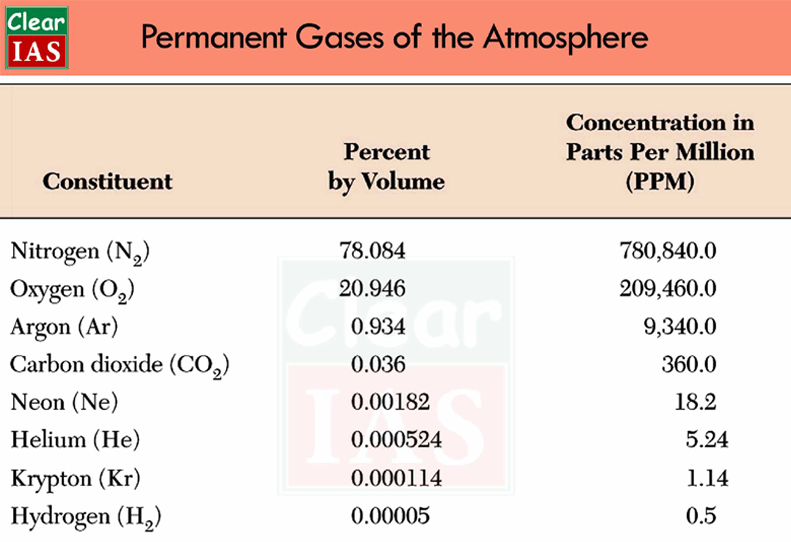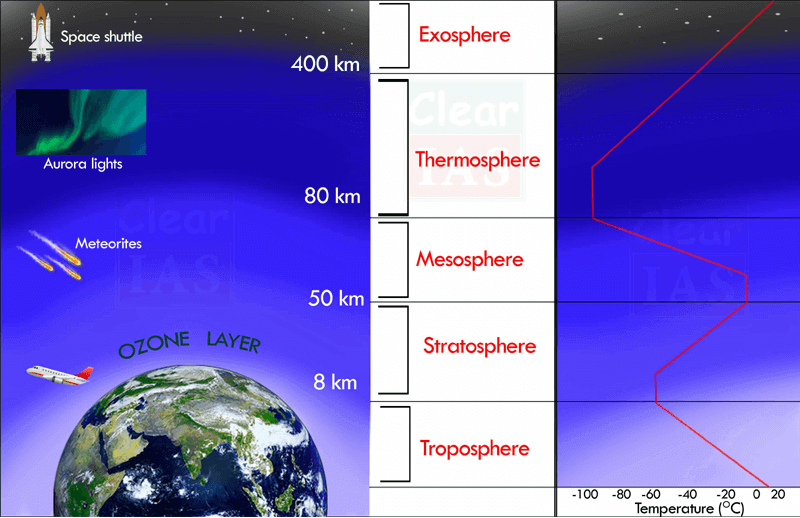 ClearIAS Team has been receiving a lot of support and encouragement from our loving readers for our easy-to-understand articles on Geography. (See Major Ocean Currents: How to learn faster?) Having covered most of the important concepts in Lithosphere and Hydrosphere, in this article, we are going to discuss the composition and structure of the Earth’s Atmosphere in detail.
ClearIAS Team has been receiving a lot of support and encouragement from our loving readers for our easy-to-understand articles on Geography. (See Major Ocean Currents: How to learn faster?) Having covered most of the important concepts in Lithosphere and Hydrosphere, in this article, we are going to discuss the composition and structure of the Earth’s Atmosphere in detail.
What is atmosphere?

We all know that earth is a unique planet due to the presence of life. The air is one among the necessary conditions for the existence of life on this planet. The air is a mixture of several gases and it encompasses the earth from all sides. The air surrounding the earth is called the atmosphere.
- Atmosphere is the air surrounding the earth.
- The atmosphere is a mixture of different gases. It contains life-giving gases like Oxygen for humans and animals and carbon dioxide for plants.
- It envelops the earth all round and is held in place by the gravity of the earth.
- It helps in stopping the ultraviolet rays harmful to the life and maintains the suitable temperature necessary for life.
- Generally, atmosphere extends up to about 1600 km from the earth’s surface. However, 99 % of the total mass of the atmosphere is confined to the height of 32 km from the earth’s surface.
Composition of the atmosphere
- The atmosphere is made up of different gases, water vapour and dust particles.
- The composition of the atmosphere is not static and it changes according to the time and place.
Gases of the atmosphere

- The atmosphere is a mixture of different types of gases.
- Nitrogen and oxygen are the two main gases in the atmosphere and 99 percentage of the atmosphere is made up of these two gases.
- Other gases like argon, carbon dioxide, neon, helium, hydrogen, etc. form the remaining part of the atmosphere.
- The portion of the gases changes in the higher layers of the atmosphere in such a way that oxygen will be almost negligible quantity at the heights of 120 km.
- Similarly, carbon dioxide (and water vapour) is found only up to 90 km from the surface of the earth.
Carbon dioxide:
- Carbon dioxide is meteorologically a very important gas.
- It is transparent to the incoming solar radiation (insolation) but opaque to the outgoing terrestrial radiation.
- It absorbs a part of terrestrial radiation and reflects back some part of it towards the earth’s surface.
- Carbon dioxide is largely responsible for the greenhouse effect.
- When the volume of other gases remains constant in the atmosphere, the volume of the carbon dioxide has been rising in the past few decades mainly because of the burning of fossil fuels. This rising volume of carbon dioxide is the main reason for global warming.
Ozone gas:
- Ozone is another important component of the atmosphere found mainly between 10 and 50 km above the earth’s surface.
- It acts as a filter and absorbs the ultra-violet rays radiating from the sun and prevents them from reaching the surface of the earth.
- The amount of ozone gas in the atmosphere is very little and is limited to the ozone layer found in the stratosphere.
Water Vapour
- Gases form of water present in the atmosphere is called water vapour.
- It is the source of all kinds of precipitation.
- The amount of water vapour decreases with altitude. It also decreases from the equator (or from the low latitudes) towards the poles (or towards the high latitudes).
- Its maximum amount in the atmosphere could be up to 4% which is found in the warm and wet regions.
- Water vapour reaches in the atmosphere through evaporation and transpiration. Evaporation takes place in the oceans, seas, rivers, ponds and lakes while transpiration takes place from the plants, trees and living beings.
- Water vapour absorbs part of the incoming solar radiation (insolation) from the sun and preserves the earth’s radiated heat. It thus acts like a blanket allowing the earth neither to become too cold nor too hot.
- Water vapour also contributes to the stability and instability in the air.
Dust Particles
- Dust particles are generally found in the lower layers of the atmosphere.
- These particles are found in the form of sand, smoke-soot, oceanic salt, ash, pollen, etc.
- Higher concentration of dust particles is found in subtropical and temperate regions due to dry winds in comparison to equatorial and polar regions.
- These dust particles help in the condensation of water vapour. During the condensation, water vapour gets condensed in the form of droplets around these dust particles and thus clouds are formed.
Structure of the atmosphere

The atmosphere can be divided into five layers according to the diversity of temperature and density. They are:
- Troposphere
- Stratosphere
- Mesosphere
- Thermosphere (Ionosphere)
- Exosphere
Troposphere
- It is the lowermost layer of the atmosphere.
- The height of this layer is about 18 km on the equator and 8 km on the poles.
- The thickness of the troposphere is greatest at the equator because heat us transported to great heights by strong convectional currents.
- Troposphere contains dust particles and water vapour.
- This is the most important layer of the atmosphere because all kinds of weather changes take place only in this layer.
- The air never remains static in this layer. Therefore this layer is called ‘changing sphere’ or troposphere.
- The environmental temperature decreases with increasing height of the atmosphere. It decreases at the rate of 1 degree Celsius for every 165 m of height. This is called Normal Lapse Rate.
- The zone separating troposphere from the stratosphere is known as tropopause.
- The air temperature at the tropopause is about – 80 degree Celsius over the equator and about – 45 degree Celsius over the poles. The temperature here is nearly constant, and hence, it is called tropopause.
Stratosphere
- Stratosphere is found just above the troposphere.
- It extends up to a height of 50 km.
- The temperature remains almost the same in the lower part of this layer up to the height of 20 km. After this, the temperature increases slowly with the increase in the height. The temperature increases due to the presence of ozone gas in the upper part of this layer.
- Weather related incidents do not take place in this layer. The air blows horizontally here. Therefore this layer is considered ideal for flying of aircraft.
- The upper limit of the stratosphere is known as stratopause.
- One important feature of stratosphere is that it contains a layer of ozone gas.
- The relative thickness of the ozone layer is measured in Dobson Units.
- It is mainly found in the lower portion of the stratosphere, from approximately 20 to 30 km above the earth’s surface.
- It contains a high concentration of ozone (O3) in relation to other parts of the atmosphere.
- It is the region of the stratosphere that absorbs most of the sun’s ultra-violet radiations.
Mesosphere
- It is the third layer of the atmosphere spreading over the stratosphere.
- It extends up to a height of 80 km.
- In this layer, the temperature starts decreasing with increasing altitude and reaches up to – 100 degree Celsius at the height of 80 km.
- Meteors or falling stars occur in this layer.
- The upper limit of the mesosphere is known as mesopause.
Thermosphere
- This layer is located between 80 and 400 km above the mesopause.
- It contains electrically charged particles known as ions, and hence, it is known as the ionosphere.
- Radio waves transmitted from the earth are reflected back to the earth by this layer and due to this, radio broadcasting has become possible.
- The temperature here starts increasing with heights.
Exosphere
- The exosphere is the uppermost layer of the atmosphere.
- Gases are very sparse in this sphere due to the lack of gravitational force. Therefore, the density of air is very less here.
What’s next in the series: Insolation and Heat Balance of the Earth
Also read: Equatorial Electrojet (EEJ): What is Magnetic Equator and Geographic Equator?
Article by: Jijo Sudarshan






Very Nice article. It is very useful. Thanks for sharing this.
This one is very much helpful for understanding the concept deeply
ತುಂಬಾ ದಾನ್ಯವಾದಗಳು self preparation ge tumba help aagta ide nange😍
I am very thankful to clearIAS team, as they provides us the useful info. For cracking the IAS
Thank You.
Sir,can we get topics separately or objective types….
how to download these notes
Thanks clearias.com
Your material is excellent, I am your regular user. Thanks for providing material free of cost . Sir thanks for providing material in sequence this was the only one thing which was not good in your material.
Because continuity is very essential.
Plz provide all material in sequence manner.
Hi Nikhil, thank you for the feedback and great to know that readers like you value our content so much. We regularly update our most important notes in sequence manner in the link – https://www.clearias.com/downloads/. We hope you would find this helpful.
Nice
VERY INFORMATIVE ANSD USWFUL FOE IAS EXAM—THANKS
It is very good notes and understanding is easier.Tiss
It is very good and attractive note for all types students.
Thanks to clearIAS team
Bravo best article
Great and motivating
IT IS VERY NICE ARTICLE. THANKS FOR SHARING SUCH A HELPFUL NOTES
Important notes thanks😊
These notes are very specific,to the point and easy understand.thnq for sharing
Nice thanks for explanation
Thnkqu so much for this information 🙏
Super not match all details with NCERT
Sorry – C02 is not the major greenhouse gas. CO2 is a poor greenhouse gas. The primary greenhouse ‘gas’ is water vapour in clouds. CO2 is not causing global warming!
very very helpful thanks sir
sir please make available pdf of these notes i really want these notes in pdf kindly help me these notes are very useful plzz make me avilable them
very helpful
thanks
Great info of Earth’s stratosphere specially the uv rays. But not all uv lights are negative some can help us destroy harmful bacteria and viruses. Kindly visit our site at https://uvraylights.com/ so we can offer our products and services thank you.